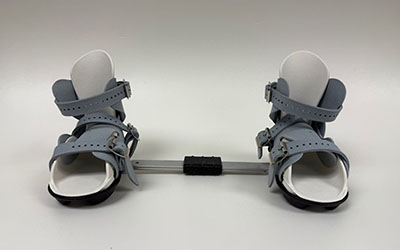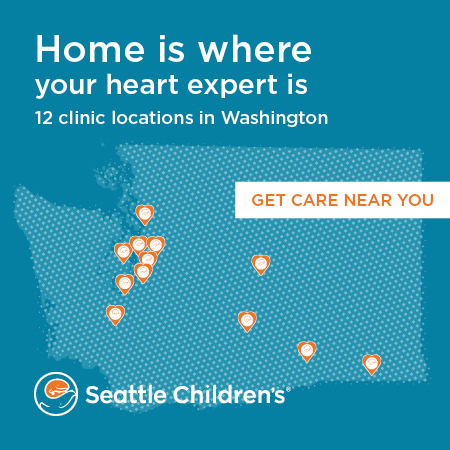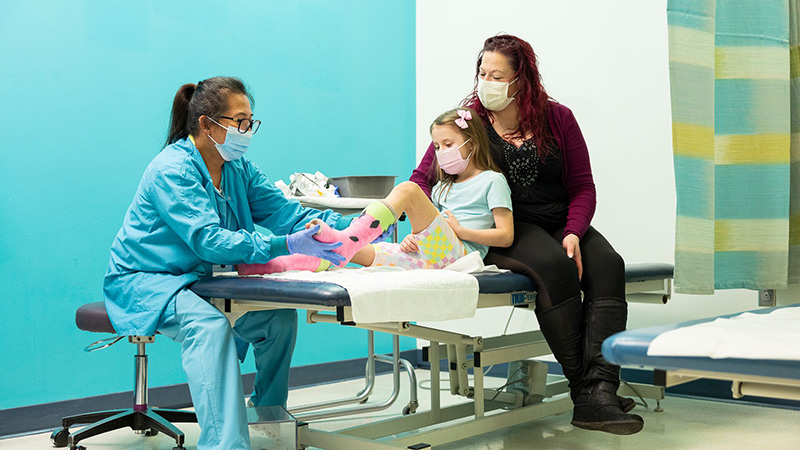Vertical Talus
What is vertical talus?
The talus is a small bone in the ankle. It’s below the bones of the lower leg and above the heel bone. Typically, the talus points toward the toes. In vertical talus, it points down toward the bottom of the foot. The forefoot (from the middle of the foot to the toes) points up toward the body. This creates a foot with an upside-down arch that looks like the rocker of a rocking chair.
Children who have vertical talus are born with it. They may have it in one or both feet. About half have another condition that affects their muscles, bones or nerves, like arthrogryposis, cerebral palsy, myelomeningocele, spina bifida or Marfan syndrome.
Treatment can correct vertical talus. With the right care, most children do well. They go on to have a pain-free foot that looks and works in typical ways.
Vertical Talus Care at Seattle Children’s
What are the symptoms of vertical talus?
Usually, it’s easy to see at birth that a baby’s foot is stiff and has the rocker shape. Sometimes, it’s not as clear until they are a little older and begin to walk.
By itself, vertical talus isn’t painful for babies. However, if it’s not treated early in life, then it will cause pain, calluses and skin damage when a child starts walking. They will walk on the inside of their foot, affecting how they move and balance. It will also be difficult to find shoes that fit well and feel comfortable.
How is vertical talus diagnosed?
A doctor will examine your child, looking at, feeling and moving their feet and ankles. The doctor will also look for signs that your child might have a different foot or ankle issue or another condition that is sometimes linked with vertical talus.
To get more details about your child’s foot and ankle, the doctor may ask for . Sometimes another type of imaging study is helpful, such as a or .
Sometimes, doctors can diagnose vertical talus based on what they see during an before a baby is born.
How is vertical talus treated?
We treat vertical talus with a series of casts followed by minimally invasive surgery and then bracing. The goal of casting is to make the foot more flexible and reduce the amount of surgery. After surgery, we use bracing to help hold your child’s new foot shape to get the best results.
Serial casting (reverse Ponseti) for vertical talus
- We begin by gently stretching your baby’s foot toward the correct position. After about a 1-minute stretch, we apply a cast that goes from the hip to the toes.
- We work with your baby each week, gently stretching the foot farther and putting on a new full-leg cast. This approach is sometimes called serial casting or reverse Ponseti casting. (The Ponseti method is used to treat clubfoot.)
- Most babies need about 4 to 6 weeks of casting. Some need less, and some more. We will tailor the schedule to your baby.
- After casting, the doctor will make a plan for surgery based on how much more change your child’s foot needs.
Surgery for vertical talus
- The exact steps for surgery depend on the position of your child’s bones and how much movement their and will allow.
- Usually, the surgeon makes the tendons and ligaments longer so they can move the bones into the typical position. Sometimes, they only need to release the (heel cord tenotomy). Often, they need to open the soft tissue around the joint between the talus and a bone that’s next to it (talonavicular capsulotomy).
- Then the surgeon moves the bones and uses pins to hold them in place.
- After surgery, your child will be in a cast for 4 to 6 weeks. Your child’s team will remove the pins and the cast when the area has healed.

Bracing for vertical talus after surgery
 Brace worn after vertical talus surgery.
Brace worn after vertical talus surgery.- To get lasting results, your child will wear a brace (Ponseti ankle-foot orthosis and abduction bar) after the cast comes off. Without the brace, there’s a high chance the problem will come back.
- A typical plan is to wear the brace 23 hours a day for 3 months and then 12 to 14 hours a day (overnight and during naps) at least for 2 years.
- Stretching is important too. We will teach you stretches to do at home to keep your child’s feet and ankles flexible.
Why choose Seattle Children’s for vertical talus treatment?
The experts in our Foot and Ankle Deformities Program, which is part of Orthopedics and Sports Medicine, treat vertical talus.
-
The foot experts you need are here
- Our Foot and Ankle Deformities team includes experienced pediatric , , and nurses who know how to evaluate and treat all types of foot and ankle conditions.
- We can successfully treat vertical talus with a combination of stretching, casting, surgery and bracing.
- Seattle Children’s has pediatric orthopedic surgeons with expanded fellowship training in foot and ankle conditions.
- We have onsite orthotists and the largest team of physical therapists in the Pacific Northwest who specialize in the care of babies, children, teens and young adults.
-
Treatment designed for growing bodies
- Infants, children and teens are still developing, so they may need different care than adults do, like treatment that takes their growth plates into account. At Seattle Children’s, your child’s team has special training in the physical, emotional and social needs of young people.
- We understand your child’s body doesn’t stop at their foot and ankle. We see them as a whole person. For example, in our Foot and Ankle Deformities Program, we look at not only your child’s feet and ankles but also their legs, spine, strength, movement and other features that might play a role in their condition, such as nerve problems.
- We have the largest group of board-certified pediatric radiologists in the Northwest. For imaging that uses radiation, we use the lowest amount possible (PDF) to make the best image. We have a low-dose radiation X-ray machine, called the EOS. It makes safer full-body images.
-
Support for your whole family
- Having a child with a foot or ankle condition can be stressful for the whole family. From the first visit to follow-up, our team will work to give your child seamless care and make your experience here as easy on you as we can.
- Your child’s team does more than plan and provide care for your child. We also make sure you and your child understand your child’s condition and treatment options. We support you in making choices that are right for your family.
- Seattle Children’s supports your family with a range of resources. Our Child Life specialists, Family Resource Center and Guest Services are here to help.
-
Research to improve care
- Seattle Children’s is active in the Pediatric Foot Research Group, an international group of researchers studying foot and ankle differences in children.
- Our growing research program is discovering better ways to diagnose and care for children with this condition. For example, we are studying a device a child can wear on their foot that senses how they walk. The goal is to better understand their gait and plan the most effective treatment. Our research program is funded in part by the Lynn Taylor Staheli Endowed Chair in Pediatric Orthopedics.
- Outcomes research helps us know which treatments work best. For example, we use tools to ask children about their function after surgery for limb differences. Asking children about their experience is essential to improving their lives.
- We take part in several registries (databases that collect information about patients who volunteer) so we can work with doctors around the country and the world to better understand orthopedic conditions, such as foot, leg, hand and arm differences.
- Learn more about current orthopedics research at Seattle Children’s.
Contact Us
Contact Orthopedics and Sports Medicine at 206-987-2109 for an appointment, a second opinion or more information.
Providers, see how to refer a patient.
Related Links
- Foot and Ankle Deformities Program
- Orthopedics and Sports Medicine
- Physical Therapy
- Resources for foot problems
Paying for Care
Learn about paying for care at Seattle Children’s, including insurance coverage, billing and financial assistance.


